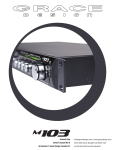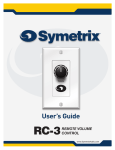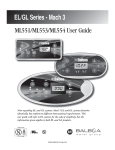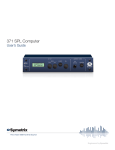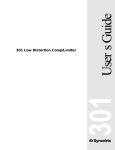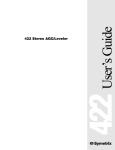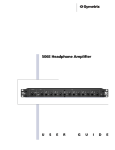Download User's Guide - Digiland Srl
Transcript
User’s Guide GENx192 www.SymetrixAudio.com User’s Guide: GENx192 6408 216th St. SW | Mountlake Terrace, WA 98043 | USA | Tel: +1 (425) 778.7728 | Fax: +1 (425) 778.7727 Safety Before You Begin What Ships in the Box ø A GENx192 hardware device. ø One detachable power cord. ø This User’s Guide. Getting Help If you have questions beyond the scope of this User’s Guide, contact our Customer Support Group in the following ways: Tel: +1 (425) 778-7728 8:00 am to 4:30 pm Monday through Friday, Pacific Time Web: http://www.SymetrixAudio.com Important Safety Instructions. ! Read these instructions. @ Keep these instructions. # Heed all warnings. $ Follow all instructions. % Do not use this apparatus near water. This apparatus shall not be exposed to dripping or splashing and no objects filled with liquids, such as vases, shall be placed on the apparatus. 503&%6$&5)&3*4,0''*3&03 8"3/*/( &-&$53*$4)0$,%0/05&9104& 5)*4&26*1.&/5503"*/03.0*4563& "7*4 3*426&%&$)0$&-&$53*26& /&1"40673*3 4&&08/&34."/6"-70*3$")*&3%*/4536$5*0/4 /PVTFSTFSWJDFBCMFQBSUTJOTJEF3FGFSTFSWJDJOHUPRVBMJGJFETFSWJDFQFSTPOOFM *MOFTFUSPVWFBMJOUFSJFVSBVDVOFQJFDFQPVSWBOUFOUSFSFQBSÊFMVTBHFS 4BESFTTFSBVOSFQBSBUFVSDPNQÊUFOU ! 1 The lightning flash with arrowhead symbol within an equilateral triangle is intended to alert the user of the presence of uninsulated “dangerous voltage” within the product’s enclosure that may be of sufficient magnitude to constitute a risk of electric shock to persons. The exclamation point within an equilateral triangle is intended to alert the user of the presence of important operating and maintenance (servicing) instructions in the literature accompanying the product (i.e. this User’s Guide). ! 1 CAUTION: To prevent electric shock, do not use the polarized plug supplied with the unit with any extension cord, receptacle, or other outlet unless the prongs can be fully inserted. ! 1 Power Source: The Lucid GENx192 hardware uses a switching power supply that automatically adjusts to the applied voltage. Ensure that your AC mains voltage is somewhere between 100-240 VAC, 50-60 Hz. Use only the power cord and connector specified for the product and your operating locale. A protective ground connection, by way of the grounding conductor in the power cord, is essential for safe operation. The appliance inlet and coupler shall remain readily operable once the apparatus has been installed. ! 1 User Serviceable Parts: There are no user serviceable parts inside this Symetrix product. In case of failure, customers inside the U.S. should refer all servicing to the Symetrix factory. Customers outside the U.S. should refer all servicing to an authorized Symetrix distributor. Distributor contact information is available online at http://www.SymetrixAudio.com. ^ Clean only with dry cloth. & Do not block any ventilation openings. Install only in accordance with the manufacturer’s instructions. This device complies with part 15 of the FCC Rules. Operation is subject to the following two conditions: (1) This device may not cause harmful interference, and (2) this device must accept any interference received, including interference that may cause undesired operation. * Do not install near any heat sources such as This Class B Digital apparatus meets all requirements of the Canadian Interference-Causing Equipment Regulations ( This apparatus shall be connected to a mains Cet appariel numerique de la classe B respecte toutes les Exigences du Reglement sur le materiel brouilleur du Canada. $"65*0/ 3*4,0'&-&$53*$4)0$, %0/0501&/ radiators, heat registers, stoves, or other apparatus (including amplifiers) that produce heat. socket outlet with a protective earthing connection. Do not defeat the safety purpose of the polarized or grounding-type plug. A polarized plug has two blades with one wider than the other. A grounding type plug has two blades and a third grounding prong. The wide blade or the third prong are provided for your safety. If the provided plug does not fit into your outlet, consult an electrician for replacement of the obsolete outlet. BL Protect the power cord from being walked on or pinched particularly at plugs, convenience receptacles, and the point where they exit from the apparatus. BM Only use attachments/accessories specified by the manufacturer. BN Use only with the cart, stand, tripod, bracket, or table specified by the manufacturer, or sold with the apparatus. When a cart is used, use caution when moving the cart/apparatus combination to avoid injury from tip-over. BO Unplug this apparatus during lightning storms or when unused for long periods of time. BP Refer all servicing to qualified service personnel. Servicing is required when the apparatus has been damaged in any way, such as powersupply cord or plug cord is damaged, liquid has been spilled or objects have fallen into the apparatus, the apparatus has been exposed to rain or moisture, does not operate normally, or has been dropped. www.SymetrixAudio.com 1 Page User’s Guide: GENx192 Introduction • Mecanical and Performance Data Introduction Every piece of digital audio equipment has an internal sample clock that controls the timing of the A/D and D/A converters and the transfer of audio through its digital audio interfaces. For optimal converter performance, the clock must be stable and free of timing irregularities known as ‘jitter’ which can induce harmonic distortion and degrade stereo imaging. Additionally, to transfer digital audio between various devices the clocks must be synchronized to a common ‘master’ timing reference, without which clicks, pops and/or low-level noise will occur. Because most digital audio devices support only a single clock input or output, many users resort to chaining clock signals from the output of one device to the input of another. Chaining clocks can lead to clock phase differences and increased jitter as the signal proceeds down the chain. The Lucid GENx192 Ultra Low Jitter Studio Master clock provides the ideal solution to most common clocking issues found in today’s recording, post-production, and broadcast environments by providing a low-jitter clock reference that can be distributed to a large number of devices simultaneously in multiple industry-standard formats and sample rates. The GENx192 features eight (8) word clock, four (4) AES clock, and two (2) S/PDIF clock outputs capable of operating at sample rates of up to 192 kHz. The outputs are divided into two groups, each having independent control over sample rate. The GENx192 can also synchronize to and re-distribute external word clock or AES signals ranging from 28 to 216 kHz. Finally, it can also function as a 1x4 AES-3 (audio) distribution amplifier. Mechanical Data Item DESCRIPTION DETAILS Rack Space Required 1U (WDH: 48.02 cm x 22.15 cm x 4.37 cm / 18.91 in x 8.72 in x 1.72 in). (Depth is specified from front panel to back of connectors.) Allow at least 1 inch additional clearance for rear panel connections. Additional depth may be required depending upon your specific wiring and connections. 100-240 VAC, 50-60 Hz, 25 Watts maximum. Universal power input - no line voltage switching required. Maximum recommended ambient operating temperature is 30 C / 86 F. Ventilation should not be impeded by covering the unit with items such as newspapers, tablecloths, curtains, etc. Electrical Ventilation Shipping Weight 3.70 kg / 8.15 lbs. Performance Data Item DESCRIPTION INPUTS: Recommended Input Level Input Impedance Word Clock: 2.0 to 5.0 Vpp (nominal); 1.0 to 7.0 Vpp (lock range) AES: 2.0 to 7.0 Vpp (nominal) Word Clock: 75Ω / 10kΩ switchable (Green “TERM” LED beneath the switch on rear panel indicates proper Word Clock input termination) AES: 110Ω OUTPUTS: Output Level Output Impedance Maximum Cable Length Word Clock: 5.2 Vpp, unterminated; 4.0 Vpp, 75Ω termination AES: > 3.6 Vpp, 110Ω termination S/PDIF: >0.3 Vpp, 75Ω termination Word Clock: 24Ω AES: 110Ω S/PDIF: 75Ω Word clock: 5 m / 16.5 ft (with 75Ω RG-59 or better coaxial cable) AES: 30.5 m / 100 ft (with 110Ω shielded twisted pair cable) S/PDIF: 10.0 m / 33 ft (with 75Ω RG-59 or better coaxial cable) 6408 216th St. SW | Mountlake Terrace, WA 98043 | USA | Tel: +1 (425) 778.7728 | Fax: +1 (425) 778.7727 2 Page Performance Data... continued • Front Panel Performance Data... continued Item DESCRIPTION SYSTEM: Internal Sample Rates 44.1 kHz and 48 kHz base rates, multiplied by 2x and 4x to 88.2 kHz, 96 kHz, 176.4 kHz, 192 kHz External Frequency Range 28 kHz to 216 kHz Clock Skew -- Any Output to Any Output TS-75 Word Clock Termination Sensing Clock Divisor Ranges < 1.00%, 28 kHz to 216 kHz, any output to any output LEDs indicate condition of clock signals based on known and expected signal voltages and source and load termination conditions Output Sense: Amber > 4.3 Vpp 4.3 Vpp ≥ Green ≥ 3.5 Vpp Red < 3.5 Vpp Input Sense: Amber > 4.4Vpp 4.4 Vpp ≥ Green ≥ 1.4 Vpp Red < 1.4 Vpp When an external clock falls within the frequency ranges prescribed below, the clock is divided down in order to create the base rate for the unit ÷1, 28kHz to 56 kHz ÷2, 56kHz to 112 kHz ÷4, 112kHz to 216 kHz FRONT PANEL ITEM RATE DESCRIPTION 8 Green LEDs DETAILS Displays the current sample clock rate as well as lock status. When SYNC SOURCE is set to INTERNAL, both the LOCK LED and the corresponding base sample RATE LED (44.1 kHz or 48 kHz) will be lit. When SYNC SOURCE is set to EXTERNAL (AES or WORD), the LOCK LED be lit when a valid clock signal ranging from 28 kHz to 216 kHz is present; if no signal is present or the clock is out of range, the LOCK LED will flash to indicate that the GENx192 is not synchronized to the clock source. When the external clock rate falls within ± 6.0% of a nominal sample rate, the corresponding RATE LED will flash. When the external clock rate falls within ± 0.2% of a nominal sample rate, the corresponding RATE LED will light solid. SYNC SOURCE 4 position rotary switch Selects either an internal oscillator (44.1 kHz or 48 kHz) or an external clock source (AES or word clock). A OUTPUTS 3 position rotary switch Sets the sample rate for the A OUTPUTS. When an internal clock is used, the switch multiplies the base rate (set by SYNC SOURCE) by either 1x, 2x, or 4x. However, when an external clock is used, the switch can act as either a multiplier or divider, depending on the rate of the external clock. For example, with an external 96 kHz clock, the GENx192 generates 96 kHz when the A OUTPUT switch is set to 96, 192 kHz when set to 192 (x2), and 48 kHz when set to 48 (÷2). See CLOCK DIVISOR RANGES for more information. B OUTPUTS 3 position rotary switch Sets the sample rate for the B OUTPUTS. Functions identically to the A OUTPUTS switch. Rocker switch Turns the unit off and on. POWER SWITCH www.SymetrixAudio.com 3 Page User’s Guide: GENx192 Rear Panel REAR PANEL ITEM DESCRIPTION DETAILS POWER INPUT IEC 3 prong jack Accepts power from detachable IEC power cable (100-240 VAC, 50-60 Hz, 25 Watts max). Connect only to a grounded power outlet. S/PDIF OUT 2 x Female RCA Transmits either AES-3 (audio) or AES-11 (sync) data formatted for unbalanced S/PDIF operating levels. Functionally identical to AES OUT. AES OUT 4 x Male XLRs Transmits either AES-3 (audio) or AES-11 (sync). When the SYNC SOURCE is set to AES and the OUTPUT switch matches the rate of the incoming AES source, then the AES output format follows the input format and the GENx192 acts as a 1x2 or 1x4 AES distributor. 8 x Female BNCs Transmits phase-aligned CMOS-level word clock signals. WORD CLOCK OUT AES IN Female XLR Accepts single-wire AES-3 or AES-11 signals at sample rates between 28 and 216 kHz. WORD CLOCK IN Female BNC Accepts TTL or CMOS-level word clock signals from 28 to 216 kHz. TERM (Switch) Push Button Toggle Switch Enables or defeats Word Clock input termination. (Green “TERM” LED beneath the switch indicates proper Word Clock input termination.) 9 x Bi-color LEDs Displays the condition of the word clock input or output signal using voltage level sensing to determine whether or not the signal is present, is operating at the correct levels, and is terminated properly. An amber LED indicates an overvoltage or underterminated condition; for outputs, it can also indicate that no connection to a receiving device has been made. A red LED indicates an undervoltage or overterminated condition; for the input, it can also indicate that no connection to a source device has been made. A green LED indicates optimal signal conditions with proper voltage and termination. However, because less is known about the word clock input signal than the output (due to variances in standards and methods employed for generating word clock amongst the various equipment manufacturers) the tolerance range for the input is much less restrictive for the input than the output to accommodate all possible valid conditions. TERM 6408 216th St. SW | Mountlake Terrace, WA 98043 | USA | Tel: +1 (425) 778.7728 | Fax: +1 (425) 778.7727 4 Page Hardware and Connections POWER: Connect the IEC connector side of the supplied AC cord to the receptacle on the rear of the GENx192. Connect the other side of the AC cable to an AC power source that is of the correct voltage and frequency (100-240 VAC, 50-60 Hz). Use only the power cord and connector specified for the product and your operating locale. INPUTS (optional): If the GENx192 is being used to distribute an existing clock source, connect that clock source to either the WORD CLOCK or AES input. Both inputs may be connected simultaneously but only one input may be selected at a time using the SYNC SOURCE selection knob on the front panel. WORD CLOCK: Using a 75Ω coaxial cable (RG-59 or better) terminated with male BNC connectors, connect one end to any of the eight GENx192 WORD CLOCK outputs, and the other end into your destination device’s word clock input. Repeat as necessary to connect additional devices. AES CLOCK: Using a 110Ω shielded, twisted pair cable terminated with one male and one female XLR connector, connect the female end to any of the four GENx192 AES outputs and the male end into your destination device’s AES input. Repeat as necessary to connect additional devices. NOTE: Be sure that the designated AES input of your destination device can be configured as an AES sync source for that device. S/PDIF CLOCK: Using a 75Ω coaxial cable (RG-59 or better) terminated with male RCA connectors, connect one end to either GENx192 S/PDIF output and the other end into your destination device’s S/PDIF input. NOTE 1: Many consumer and “pro-sumer” devices do not offer Word or AES clock inputs. However, of those devices, many do have S/PDIF digital audio inputs, such as the Digidesign 001 and 002 workstations. These devices typically allow the S/PDIF input to be a sync source while allowing concurrent audio throughput from both the S/PDIF and other ports (such as ADAT Optical). If your device fits this profile, the GENx192’s S/PDIF output will allow that device to finally sync to the outside world! NOTE 2: There is no clock-only specification for S/PDIF digital audio, as there is within the AES specification. Therefore, the S/PDIF output of the GENx192 is simply an unbalanced, transformer-coupled copy of the AES outputs. Most S/PDIF inputs will accept the AES-formatted data, but compatilbility is not always guaranteed. www.SymetrixAudio.com 5 Page User’s Guide: GENx192 Basic Setup: Front Panel $B Outputs Sample Rate Multiplier %Power On/Off !Lock and Rate Indicator LEDs @Sync Source Selector #A Outputs Sample Rate Multiplier AES OUT =djhZHncX dei^dcVa WORD IN WORD IN 9^\^iVaB^mZg 6$99$68dckZgiZg WORD IN WORD IN 9^\^iVa:[[ZXih 9Zk^XZ 9^\^iVaGZXdgYZg Basic Setup - Illustration 3. Repeat step 2 for B OUTPUTS if necessary. This illustration details the connections of a typical master clock setup in a visual format. In this setup, analog audio is handled by an external A/D and D/A converter such as a Lucid 88192. After the converter, all audio is digital between a digital multitrack recording device and a digital mixer. All devices sync to a dedicated word clock provided by the GENx192. The GENx192’s user interface consists of three simple multi-position selector knobs. Follow the guidelines below to setup the GENx192 for use in the example shown above. A. Power on. B. Select the SYNC SOURCE and set the SYNC RATE: 1. Turn the SYNC SOURCE knob to select the internal base rate of either 44.1 kHz or 48 kHz based upon the desired final output rate. For example, select 48 if you want 48 kHz, 96 kHz, or 192 kHz. Select 44.1 if you want 44.1 kHz, 88.2 kHz or 176.4 kHz. Both the green LOCK LED and the 44.1 or 48 green RATE LED rate will light. 2. Turn the A OUTPUTS knob to select the desired final output rate. This is a multiple (1x, 2x or 4x) of the base selected in step one. If you’re connecting the GENx192 to an external sync source then proceed as follows: A. Power on. B. Select the SYNC SOURCE and set the SYNC RATE: 1. Turn the SYNC SOURCE knob to AES or WORD. If a valid AES or WORD input is present then the LOCK LED will light. A flashing LOCK LED indicates that the selected SYNC SOURCE is either not present, out of range, or unusable. A RATE LED will flash when the external clock rate falls within ± 6.0% of the indicated RATE. A RATE LED will light solid when the external clock rate falls within ± 0.2% of the indicated RATE. 2. Turn the A OUTPUTS knob to select the desired final output rate. 3. Repeat step 2 for B OUTPUTS if necessary. Note: Should the external sync source become disconnected or interrupted in some way, the GENx192 will switch to an internal clock that is closest to the external clock rate. The GENx192 will continue to output sync at the closest internal rate until it is once again able to lock to a valid external source. 6408 216th St. SW | Mountlake Terrace, WA 98043 | USA | Tel: +1 (425) 778.7728 | Fax: +1 (425) 778.7727 6 Page Clocks, Cables and Termination Sample Clocks Common Clocking Problems Within each piece of digital audio equipment are one or more clocks that control signal and timing relationships between various internal components and external devices. The sample clock controls the A/D and D/A conversion rate and timing of audio signal transfers through digital interfaces such as AES, TDIF, and ADAT optical. The rate at which this clock runs is known as the Sample Rate. The most common ‘standard’ sample rates used in professional audio are 44.1 kHz and 48 kHz, from which many other less common rates are derived. Insuring proper system synchronization requires not only paying attention to the software and/or hardware configuration of each device in the system, but also using the correct interconnection hardware (cabling, connectors, termination) and employing the appropriate interconnection topology. Failing to do so may result in any one of a number of common synchronization problems, some of which are not readily perceptible or easy to diagnose. To properly receive a digital signal transmitted from another device, the sample clocks of both sending and receiving devices must precisely match each other. To use an analogy, imagine a machine placing parts onto a conveyor belt, while another machine picks the parts off the other end of the belt and packages them. If both the first machine and the belt are running at a constant rate, then the packaging machine must also take the parts off the line at precisely the same rate. Not only must the packaging macine run at the identical rate, it must also pick the part off the belt at the exact moment the part passes it. If the alignment is out of whack, then even though the packaging macine runs at the correct speed, it will miss every part. As everyone knows, if you take two wristwatches, set them to the exact same time and start them at the same moment, a week later they will not read the same time. The crystal oscillators used to generate the sample clock inside each digital audio device are no different - no two crystal oscillators run at exactly the same rate. Therefore they must be synchronized externally using a common ‘master’ clock signal that provides both frequency (rate) and position (alignment) information. This master clock can be either any digital device in the system, or a dedicated clock generator such as the GENx192. Most professional audio equipment, including DAT machines, digital consoles, A/D and D/A converters, and DAWs can slave their internal sample clock to an external sample clock, unlike most consumer audio devices which cannot (such as CD players with digital outputs). Jitter: Jitter refers to the amount of aperiodicity in a clock signal, and is generally measured in ‘nanoseconds’ (ns or 10-9 s). For example, a jitter-free 50 kHz clock has exactly one clock cycle every 20µs (10-6 s). If the period of this clock changes from 19.997 µs to 20.001 µs from one moment to the next, then the clock is said to have 4 ns of jitter because the period varies by 4ns. Jitter degrades the quality of the analog-to-digital and digital-to-analog conversion process by inducing harmonic distortion into the signal, and therefore is hard to notice without comparing it to an ideal (extremely low jitter) signal within the same listening environment. Jitter can also ‘smear’ the sharpness of a stereo image created with phase-coherent micing techniques (e.g. stereo-mic’d acoustic guitar). Because jitter can be considered as a signal that modulates an ideal clock, it also has a frequency spectrum which affects the character of the distortion. Jitter is the cumulative effect of numerous causes, ranging from poor grounding to the characteristics of the internal circuitry of the equipment itself (noisy power supplies, signal crosstalk, circuit components, etc). While some of these factors cannot be controlled, external factors such as cabling, termination, and clock distribution method can play a significant contributing role. Drift: Drift occurs when two or more audiovisual record/playback systems (DAW, digital tape, video, etc.) do not share a common master clock. The problem is a direct consequence of the wristwatch illustration used above: when two DAWs are both set to internal clocks at the same sample rate, and if they contain identical audio material and are started at exactly the same time, then over time one DAW will begin to play back behind the other. Whereas it may take hours or days for two wristwatches to drift from each other appreciably, in the digital world it typically takes only seconds or minutes for noticeable drift to accumulate. Drift is invariably caused by a failure to set up the operating parameters of the equipment correctly or to make the correct synchronization connections. Pops, Clicks, Hash, and Distortion: Pops and clicks occur when the clocks between two digitally interconnected devices running at different clock rates (for reasons stated above) move into and out of alignment with each other. As misalignment occurs audio data is ‘dropped’, creating a discontinuity in the audio data. Similar to the beating of two closely tuned strings, these pops and clicks occur at the same rate as the difference in speed between the two clocks. If the clock rate difference is very slight, then the clocks will undergo a protracted period wherein data will be dropped, causing a long burst of noise or ‘hash’ instead. In its most extreme forms (when jitter becomes > 5 to 10% of the clock period), jitter can induce the same problems except that the period and rate of popping and distortion will be random. www.SymetrixAudio.com 7 Page User’s Guide: GENx192 Clocks, Cables and Termination... continued In most cases such problems are immediately noticeable, and with a little listening and a bit of deductive reasoning the source of the problem can be quickly found. Some problems are less apparent. Program material, listening levels and monitor systems as well as certain types of digital interfaces can tend to mask the problem, which although present, tends to be present at much lower levels in the material. When the clock rate difference is dramatic (for example when a system running at 44.1 kHz is interfaced to another running at 48 kHz), then discrete pops and clicks cannot be heard. Instead, the ‘resampled’ signal results in aliasing and severe harmonic distortion that sounds grainy and ‘digital’, particularly in the high frequencies. Skew – Skew is a misalignment of two clocks whose rates are otherwise synchronized. Skew is almost always caused when devices are synchronized by chaining synchronization signals serially from one device to the other, instead of to all devices from a single device. Skew can cause pops and clicks if the receiving device cannot receive data from the transmitting device because of the particular phase relationship of the clocks. Skew can also cause timing differences in the A/D and D/A conversion processes which can cause slight highfrequency phase cancellation and image smearing if phase coherent material is distributed across the various sources. Skew should not be a problem in properly designed equipment when the proper interconnection topology is used. Clock Distribution: Three Common Approaches There are several types of sample clock signals commonly used today: word clock, AES-3, AES-11, S/PDIF, and ADAT Optical. The GENx192 provides all of these except for ADAT Optical. AES-3, S/PDIF, and ADAT Optical are known as self-clocking interfaces because they carry both audio signals and clock data which receiving devices can slave their sample clocks to. Word clock and AES-11 carry no audio information – they are synchronization signals only. There are three ways to distribute clock signals: in a serial chain, in a parallel chain, or in a star configuration. Often times a setup may be a combination of two or three distribution methods. Clock Distribution: Star In a star configuration, a single ‘master’ generator distributes a clock signal to each device that requires it. MASTER CLOCK OUT 1 CLOCK OUT 2 SLAVE #1 CLOCK IN CLOCK OUT SLAVE #N CLOCK IN CLOCK OUT Malfunction: At worst, some devices cease to pass audio altogether when they cannot lock to an external clock. In other cases their PLLs (Phase Locked Loops) may drift to invalid sample rates quite far from the target sample rate and create all varieties of audible havoc both internally and with other interconnected audio devices. Fortunately, employing a low jitter, low skew, centralized master clock / distributor like the Lucid GENx192 can solve most, if not all, of the above mentioned potential problems. Cabling Always use the correct cabling recommended for each type of clock signal. Improper cabling can lead to several of the problems described previously, such as clock signal degradation and jitter. The longer the cable run, the more critical it is to use the correct cable. Word Clock: Use 75Ω video coax (RG-59 or RG-6) with properly matched 75Ω BNC connectors. In a pinch you may substitute 50Ω coax (RG-58) for very short runs. Any use of 50Ω coaxial cable with a properly terminated word clock input will cause signal reflections at the connector that can induce clock jitter. AES: Use 110Ω shielded, twisted pair digital audio cable. Because of the extremely high bandwidth of AES signals (up to 25 MHz), microphone cable should never be used for AES signals, even for very short runs. S/PDIF: Use 75Ω video coax (RG-59 or or RG-6) with RCA male connectors designed for attachment to coaxial cable. Unlike word clock, 50 Ω coax should not be used. Without exception Star distribution should be used for every device that has a word clock or AES-11 (i.e. non self-clocking) input. For this reason the GENx192 was designed with a large number of clock outputs to facilitate a proper star distribution within all but the most demanding production environments. If at all possible, this is the way to go! Belden, Canare, and Mogami all make excellent coaxial and digital audio cables that work well in these applications. 6408 216th St. SW | Mountlake Terrace, WA 98043 | USA | Tel: +1 (425) 778.7728 | Fax: +1 (425) 778.7727 8 Page Clocks, Cables and Termination... continued Clock Distribution: Parallel Clock Distribution: Serial In parallel clock distribution (word clock only), the clocks of multiple devices are connected to the same signal in parallel using “T” connectors. In a proper parallel setup, the device at the end of the chain is terminated (low-impedance), and all devices in between are unterminated (high-impedance) so as not to adversely load the signal down. In serial clock distribution, clocks are chained from the output of one device to the input of another. Serial distribution has several drawbacks and should be used only for devices that have self-clocking interfaces (e.g. certain DAT machines and stand-alone CD burners, digital effects processors, etc.) These drawbacks include: MASTER SLAVE #1 SLAVE #N CLOCK IN CLOCK IN CLOCK IN CLOCK OUT CLOCK OUT Signal Degradation: As the signal is passed from one device to another, the signal quality can become degraded the farther down the chain it gets. Clock Skew: Devices may add a small amount of delay to the output signal causing the clock edge to become progressively misaligned between each device in the chain. Added Jitter: Each device has an inherent amount of jitter in its internal clocks. If the device regenerates the clock rather than passing it through then the inherent jitter of the device will get added to the jitter contributed by all previous devices. Any signal quality degradation will only exacerbate the jitter problem. MASTER CLOCK IN CLOCK OUT SLAVE #1 CLOCK IN CLOCK OUT SLAVE #N CLOCK IN CLOCK OUT CLOCK OUT BNC 75 Ohm Terminator Parallel distribution can be used effectively, but it also has drawbacks: Termination Problems: Some manufacturers do not clearly mark the termination (input) impedance of their word clock inputs. Thus it is quite easy to have two or more devices in the chain which are both terminated, causing a sharp drop in clock signal level leading to synchronization failure in one or more devices. The GENx192 termination sensing LEDs are designed to aid in diagnosing problems with multiple terminated inputs. Reliability: Having multiple cables and multiple BNC-T connectors in the chain can lead to a higher incidence of mechanical failure. Lack of Flexibility: Many devices cannot be unterminated, and therefore cannot be connected together in the same parallel chain. www.SymetrixAudio.com 9 Page User’s Guide: GENx192 Clocks, Cables and Termination... continued Termination and Word Clock Drive Levels Unlike AES-3, AES-11, and S/PDIF, there are no published standards for word clock. While over the years certain common word clock circuit design practices have emerged, compatibility between manufacturers is not guaranteed in all cases. Some devices do not have sufficient output voltage to drive a properly terminated word clock input, while others require an unusually high input signal voltage to work properly. When two such devices are mated the result is that the receiving device may intermittently lose lock or simply not lock at all. The GENx192 was designed to be compatible with all equipment on the market today. For ideal word clock transmission conditions to exist, the end of the cable must be ‘terminated’ with a load impedance that exactly matches the cable impedance (75Ω.) “Ringing” occurs at the clock input when there is an impedance mismatch, adding jitter to the signal. Many devices are by default internally terminated with a 75Ω resistor; others are either user selectable (through a switch or jumper), or are completely unterminated. Consult the operator’s manual for each piece of equipment to determine the word clock input impedance. AES and S/PDIF do not have these termination issues – properly designed AES and S/PDIF circuits should be correctly terminated already. For point to point connections (such as in a star configuration), the word clock input should always be terminated. If the device at the end of the cable cannot be internally terminated, then an external 75Ω BNC terminator and BNC-T connector must be installed. In a parallel configuration only the device at the end of the cable should be terminated, and all devices in the middle must be unterminated (high-impedance). A ‘double-termination’ condition results when two devices on the same clock leg are terminated. This results in drastically lower clock voltage, and one or more of the units may fail to lock to the clock. Interfacing to Analog Systems Even today where the significant majority of recording and playback systems are digital, it is still necessary in certain production environments to synchronize the playback of analog systems such as VTR and multitrack tape machines to digital systems that require clock synchronization. In the digital domain, word clock and AES-3/11 are used as timing references, whereas in the analog domain video signals are commonly used. To synchronize a VTR or analog multitrack to a digital system it is necessary to use a video blackburst signal as the master timing reference. Blackburst is typically distributed from a single ‘house sync’ or stand-alone blackburst generator. Most digital systems do not have video sync inputs. It is therefore necessary to use a second clocking device that can receive a video signal and output a ‘resolved’ digital sample clock that can be distributed through a device such as the GENx192 to all the digital equipment that requires it; a few generators can output both blackburst and resolved sample clock signals. These resolvers work as synchronization ‘gearboxes’ by mathematically relating the video signal to the sample clock. For example, a resolver can generate a 48 kHz sample clock from a 30 Hz video signal by outputting (48,000/30) = 1600 samples for every video frame. Some DAWs and MDMs have video sync inputs as well as clock inputs. It is acceptable to use the video sync inputs on these devices in lieu of clock ONLY when using analog inputs and outputs exclusively, AND when phase-coherent audio is NOT distributed between the video synchronized devices(s) and other devices in the system. In all other cases, a valid clock system must be used, particularly when using digital inputs and outputs. The reason for this is that in most video resolving circuits, although the video frame rate can be adequately resolved to the sample clock rate, the phase alignment between the video and clock signals is arbitrary. Therefore, if two devices are interconnected digitally but both resolved to black burst, the clock alignment will be arbitrary and may cause misclocking. 6408 216th St. SW | Mountlake Terrace, WA 98043 | USA | Tel: +1 (425) 778.7728 | Fax: +1 (425) 778.7727 10 Page Declaration of Conformity Declaration of Conformity We, Symetrix Inc., 6408 216th St. SW, Mountlake Terrace, Washington, USA, declare under our sole responsibility that the product: GENx192 Ultra Low Jitter Studio Master Clock to which this declaration relates, is in conformity with the following standards: EN 60065 Safety requirements for mains operated electronic and related apparatus for household and similar general use. EN 55103-1 Electromagnetic compatibility - Generic emission standard Part 1: Residential, commercial, and light industry. EN 55103-2 Electromagnetic compatibility - Generic immunity standard Part 1: Residential, commercial, and light industry. The technical construction file is maintained at: Symetrix, Inc. 6408 216th St. SW Mountlake Terrace, WA, 98043 USA The authorized representative located within the European Community is: World Marketing Associates P.O. Box 100 St. Austell, Cornwall, PL26 6YU, U.K. Date of issue: January 06, 2006 Place of issue: Mountlake Terrace, Washington, USA Authorized signature: Dane Butcher, President, Symetrix Incorporated. www.SymetrixAudio.com 11 Page Warranty and Service The Symetrix Limited Warranty Symetrix, Inc. expressly warrants that the product will be free from defects in material and workmanship for eighteen (18) months from the date the product is shipped from the factory. Symetrix’s obligations under this warranty will be limited to repairing or replacing, at Symetrix’s option, the part or parts of the product which prove defective in material or workmanship within eighteen (18) months from the date the product is shipped from the factory, provided that the Buyer gives Symetrix prompt notice of any defect or failure and satisfactory proof thereof. Products may be returned by Buyer only after a Return Authorization number (RA) has been obtained from Symetrix. Buyer will prepay all freight charges to return the product to the Symetrix factory. Symetrix reserves the right to inspect any products which may be the subject of any warranty claim before repair or replacement is carried out. Symetrix may, at its option, require proof of the original date of purchase (dated copy of original retail dealer’s invoice). Final determination of warranty coverage lies solely with Symetrix. Products repaired under warranty will be returned freight prepaid via United Parcel Service by Symetrix, to any location within the Continental United States. Outside the Continental United States, products will be returned freight collect. The foregoing warranties are in lieu of all other warranties, whether oral, written, express, implied or statutory. Symetrix, Inc. expressly disclaims any IMPLIED warranties, including fitness for a particular purpose or merchantability. Symetrix’s warranty obligation and buyer’s remedies hereunder are SOLELY and exclusively as stated herein. This Symetrix product is designed and manufactured for use in professional and studio audio systems and is not intended for other usage. With respect to products purchased by consumers for personal, family, or household use, Symetrix expressly disclaims all implied warranties, including but not limited to warranties of merchantability and fitness for a particular purpose. This limited warranty, with all terms, conditions and disclaimers set forth herein, shall extend to the original purchaser and anyone who purchases the product within the specified warranty period. Symetrix does not authorize any third party, including any dealer or sales representative, to assume any liability or make any additional warranties or representation regarding this product information on behalf of Symetrix. This limited warranty gives the buyer certain rights. You may have additional rights provided by applicable law. Note: Some Symetrix products contain embedded software and may also be accompanied by control software intended to be run on a personal computer. Said software is specifically excluded from this warranty. Limitation of Liability The total liability of Symetrix on any claim, whether in contract, tort (including negligence) or otherwise arising out of, connected with, or resulting from the manufacture, sale, delivery, resale, repair, replacement or use of any product will not exceed the price allocatable to the product or any part thereof which gives rise to the claim. In no event will Symetrix be liable for any incidental or consequential damages 12 Page www.SymetrixAudio.com including but not limited to damage for loss of revenue, cost of capital, claims of customers for service interruptions or failure to supply, and costs and expenses incurred in connection with labor, overhead, transportation, installation or removal of products, substitute facilities or supply houses. Servicing Your Symetrix Product If you have determined that your Symetrix product requires repair services and you live outside of the United States please contact your local Symetrix dealer or distributor for instructions on how to obtain service. If you reside in the U.S. then proceed as follows. Return authorization At the Symetrix factory, Symetrix will perform in-warranty or out-ofwarranty service on any product it has manufactured for a period of three (3) years from date of discontinued manufacture. Before sending anything to Symetrix, please contact our Customer Service Department for a return authorization (RA) number. The telephone number is +1 (425) 778-7728. Additionally support is available via the web site: http://www.SymetrixAudio.com. In-warranty repairs To get your Symetrix product repaired under the terms of the warranty: 1. Call us for an RA number (have the serial number, shipping and contact information and description of the problem ready). 2. Pack the unit in its original packaging materials. 3. Include your name, address, daytime telephone number, and a brief statement of the problem. 4. Write the RA number on the outside of the box. 5. Ship the unit to Symetrix, freight prepaid. We do not accept freight collect shipments. Just do these five things, and repairs made in-warranty will cost you only one way freight charges. We’ll pay the return freight. If you don’t have the factory packaging materials, we recommend using an oversize box. Wrap the unit in a plastic bag, surround it with bubble-wrap, and place it in the box surrounded by Styrofoam peanuts. Be sure there is enough clearance in the box to protect the rack ears. We won’t return the unit in anything but Symetrix packaging for which we will have to charge you. If the problem is due to operator misuse or error, you will have to pay for both parts and labor. In any event, if there are charges for the repair, you will pay for the return freight. All charges will be COD unless you have made other arrangements (prepaid, Visa or Mastercard). Out-of-warranty repairs If the warranty period has passed, you’ll be billed for all necessary parts, labor, packaging materials, and freight charges. Please remember, you must call for an RA number before sending the unit to Symetrix. www.SymetrixAudio.com 13 Page User’s Guide: GENx192 6408 216th St. SW | Mountlake Terrace, WA 98043 | USA | Tel: +1 (425) 778.7728 | Fax: +1 (425) 778.7727 Engineered by GENx192 User’s Guide © 2008 Symetrix, Inc. All rights reserved. Printed in the United States of America. The information in this document is subject to change without notice. Symetrix, Inc. shall not be liable for technical or editorial errors or omissions contained herein; nor is it liable for incidental or consequential damages resulting from the furnishing, performance, or use of this material. Mention of third-party products is for informational purposes only and constitutes neither an endorsement nor a recommendation. Symetrix assumes no responsibility with regard to the performance or use of these products. Under copyright laws, no part of this brochure may be reproduced or transmitted in any form or by any means, electronic or mechanical, without permission in writing from Symetrix, Inc. If, however, your only means of access is electronic, permission to print one copy is hereby granted. The following are either Trademarks or Registered Trademarks of Symetrix, Inc.: Symetrix and Lucid. Windows is a Registered Trademark of Microsoft, Inc.. Other product names mentioned herein may be trademarks and/or registered trademarks of other companies and are property of their respective owners. 14 Page



















